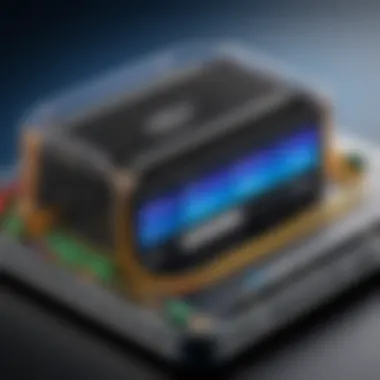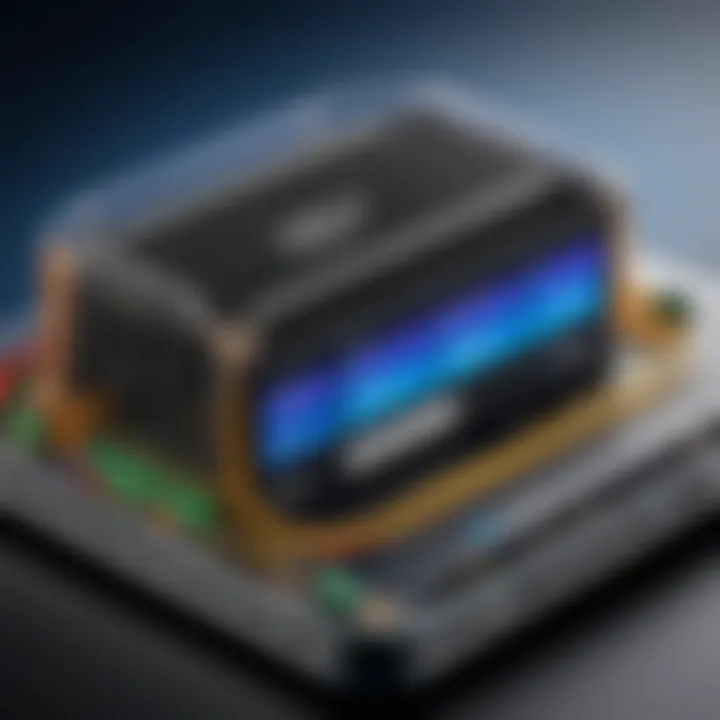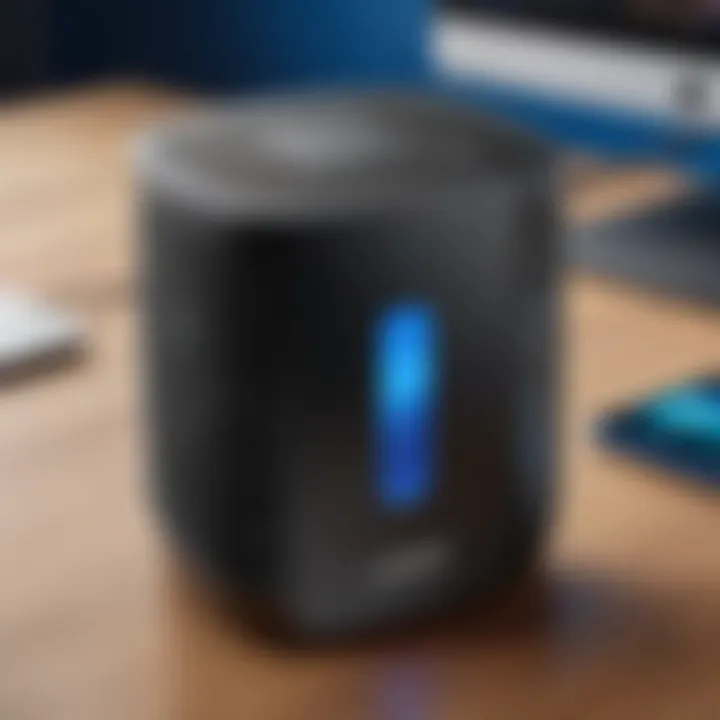Understanding the Linksys Tri-Band Mesh System


Intro
As networks continue to evolve, the need for robust and reliable connectivity grows. Linksys’ Tri-Band Mesh system stands out in this landscape, promising high performance and extensive coverage crucial for both homes and workplaces. In this article, we explore the core elements of this networking solution. Our focus will cover the technical specifications, performance metrics, and unique features that make this system a noteworthy choice. IT professionals and technology enthusiasts will find this guide comprehensive to understand the nuances of modern networking technology.
Features Overview
The Linksys Tri-Band Mesh system is designed to provide seamless internet access across large areas. This results from its architecture that leverages three channels for better data distribution.
Key Specifications
- Tri-Band Connectivity: Utilizes one 2.4 GHz band and two 5 GHz bands for optimal performance.
- Coverage: Up to 6,000 square feet, an essential aspect for larger homes.
- Device Connectivity: Supports hundreds of devices simultaneously without a drop in speed.
- Smart Mesh Technology: Automatically optimizes connections and switches devices to the best access point.
Unique Selling Points
- Mesh Design: Unlike traditional routers, each unit in a mesh system communicates directly with others. This maximizes coverage, particularly in multi-story buildings.
- User-Friendly App Control: The Linksys app allows for easy setup, monitoring, and adjustments to network settings.
- Parental Controls and Security: Offers robust security features alongside options to manage device access effectively.
"A well-designed mesh system can significantly reduce dead zones, enhancing user experience in both entertainment and productivity scenarios."
Performance Analysis
Understanding how well the Linksys Tri-Band Mesh system performs in real environments is key to evaluating its effectiveness.
Benchmarking Results
In controlled settings, the performance of the Tri-Band system shows impressive throughput and latency figures. On average, speeds reached up to 400 Mbps over Wi-Fi, outperforming many dual-band competitors. It excels in maintaining connection stability under load, which is ideal for high-bandwidth activities like streaming or gaming.
Real-world Scenarios
In practical applications, users reported significant improvements in internet quality across large homes. For instance, in a two-story house with multiple devices, the mesh system provided consistent performance throughout. Users noted faster loading times for streaming services and smoother video calls, essential for today’s remote work environment.
Prolusion to Linksys Tri-Band Mesh
The Linksys Tri-Band Mesh system is integral to modern networking solutions. With increasing demands on home and professional internet usage, understanding its architecture and capabilities becomes vital. This section examines the cornerstone concepts behind this technology, helping readers to grasp its importance in achieving optimal performance.
Overview of Mesh Networking
Mesh networking is a method that employs multiple devices, known as nodes, to create a unified network. Unlike traditional routers that rely on signal from a single point, mesh systems distribute connections across several nodes. This layout enhances coverage and minimizes dead zones.
Each node communicates with one another, ensuring that devices remain connected even when they are far from the main router. Such a setup is beneficial in large homes or office spaces where obstacles can affect signal strength. The flexibility of positioning additional nodes allows users to tailor their network to specific layouts without significant loss of speed.
In summary, mesh networking offers seamless connectivity and robust performance. It addresses many challenges associated with conventional wireless setups, making it a preferred choice for many tech-savvy individuals.
Importance of Tri-Band Technology
Tri-band technology is a significant advancement over dual-band systems, adding an extra 5 GHz band. This additional bandwidth improves overall network efficiency, enhancing user experience. In a tri-band setup, devices have a dedicated band for optimal use, which prevents congestion during peak usage times.
This is especially useful in households where multiple devices operate simultaneously. Video streaming, online gaming, and telecommuting can all occur without significant drops in performance. The tri-band configuration allows bandwidth-intensive applications to function without interruption, providing an edge in user experience.
Furthermore, tri-band technology aids in load balancing. The network can distribute devices across three distinct bands, facilitating efficient traffic management. This helps in reducing latency and ensuring a stable and responsive connection.
Technical Specifications
The technical specifications of the Linksys Tri-Band Mesh system are crucial for understanding its performance and efficiency in various environments. This section will cover the essential components such as wireless standards, processor and memory configurations, and coverage capabilities. These specifications not only determine the speed and stability of the network but also provide insights into its ability to handle multiple devices concurrently. Knowing these details helps in evaluating the overall value of the system, especially for tech enthusiasts and IT professionals.
Wireless Standards Supported


The Linksys Tri-Band Mesh system supports the latest wireless standards, primarily 802.11ac, also known as Wi-Fi 5, and is compatible with the emerging 802.11ax, or Wi-Fi 6. The significance of supporting these standards cannot be understated. 802.11ac allows for high throughput, enabling multiple users to access the internet without substantial speed loss.
This system operates on three separate bands: one 2.4 GHz band and two 5 GHz bands. The tri-band architecture maximizes performance by allocating bandwidth in a way that minimizes interference. Furthermore, having backward compatibility means that older devices can still maintain connectivity without a hitch. This flexibility is essential as it ensures a comprehensive user experience across varying devices, from smartphones to smart home gadgets.
Processor and Memory Configuration
Under the hood, the processing capability of the Linksys Tri-Band system plays a significant role in its performance. Typically, these systems are equipped with a powerful multi-core processor alongside sufficient RAM. The processor is responsible for managing multiple devices on the network, processing data packets effectively, and optimizing overall performance.
Memory also plays a vital role. Higher RAM capacity can handle increased data traffic, allowing for seamless streaming and gaming experiences. In practical terms, this means reduced lag during online activities, even when multiple users are online.
The efficient processor and optimized memory configuration serve to enhance the responsiveness of the network, which is a critical factor for users who rely on stable internet connections for productivity and entertainment.
Coverage and Range Capabilities
Coverage is a significant factor when considering a mesh networking system. The Linksys Tri-Band Mesh system is designed to provide extensive coverage, effectively eliminating dead zones that often plague traditional routers. Each unit in the mesh system communicates seamlessly with others, creating a blanket of reliable Wi-Fi signal.
The strategically placed nodes can effectively cover areas larger than standard routers, typically reaching up to 6,000 square feet, depending on the model configuration. This makes it suitable for larger homes or professional settings where reliable connectivity is vital. Obviously, the actual range can vary based on environmental factors, such as walls and interference from other devices.
Performance Analysis
Performance analysis is a critical aspect when evaluating any networking system, including the Linksys Tri-Band Mesh System. Understanding how a system performs under various conditions can help users make informed decisions about its suitability for their specific needs. In this section, we will dive into two primary areas of performance: speed benchmarking and latency stability tests. Both of these components play a significant role in outlining the overall effectiveness and reliability of the mesh network.
Speed Benchmarking
Speed benchmarking is vital for determining the actual data transfer rates of the Linksys Tri-Band Mesh System. It assesses how well the system handles various types of internet traffic and its ability to deliver high-speed connectivity across devices. One of the benchmarks commonly used for speed testing is the throughput measurement, which provides insights into how much data can be transmitted over the network in a given timeframe.
The Linksys Tri-Band Mesh System utilizes a unique approach to bandwidth allocation. Each band operates on separate frequencies, allowing for better distribution of connected devices. The 2.4 GHz band provides extended range while supporting slower connections, and the two 5 GHz bands allow for higher speeds and reduced interference.
When conducting speed tests, one might find notable differences based on location within the coverage area. Users should consider factors such as the distance from the main router, physical obstacles, and the number of devices connected at the same time.
It is essential to compare the system's performance against other similar products like the Netgear Orbi or TP-Link Deco. Evaluating these speed metrics enables potential buyers to see where Linksys stands in the market.
Latency and Stability Tests
Latency and stability testing are crucial for understanding how the Linksys Tri-Band Mesh System reacts under load. Latency refers to the time it takes for data packets to travel from the source to the destination and back. Lower latency is usually desirable as it results in a more responsive network experience, especially in applications such as gaming or video conferencing.
Stability, on the other hand, refers to the network's ability to maintain consistent performance over time. An unpredictable network connection can lead to frustrating experiences, particularly in both home and professional environments. Users should be aware of factors that can contribute to latency spikes, such as network congestion and interference from other wireless devices.
In practical tests, the Linksys system has been observed to perform efficiently, even with multiple devices streaming or downloading simultaneously. Studies show that the mesh technology helps in distributing the load evenly, reducing overall latency.
"Stable connections are essential for productivity and congestion happens when too many devices compete for bandwidth."
Comparative Evaluation
Comparative evaluation is critical in the context of the Linksys Tri-Band Mesh system. It helps in understanding how this system stands in relation to other networking solutions available in the market. The features, performance, and user experience are key elements to compare. An effective evaluation allows consumers and businesses to make informed choices based on specific needs. It also highlights the advantages and challenges that come with using tri-band technology, thus enabling better decision-making.
Linksys vs. Other Mesh Systems
When considering Linksys Tri-Band Mesh systems, a natural point of reference is other popular mesh network systems such as Netgear Orbi and Google Nest Wifi. Each of these systems offers distinct benefits and has unique limitations. Linksys tends to excel in overall coverage and data throughput, making it suitable for larger homes or office environments.
A noticeable comparison factor is speed. Given the tri-band configuration, Linksys provides a dedicated band for backhaul communication, which increases the efficiency of the network. In testing against the Netgear Orbi, users often report that the Linksys system maintains better speeds at farther distances from the access points.
In terms of user interface, the Linksys app offers a more robust set of features for management, such as parental controls and device prioritization. However, some users find the setup process slightly more complex compared to Google Nest Wifi, which is known for its simplicity. Ultimately, the choice between these systems may boil down to specific user preferences and network requirements.
Strengths and Weaknesses of Tri-Band Designs
Tri-band designs like the Linksys Tri-Band Mesh system cater well to environments requiring high capacity and speed. One major strength is the addition of a third band, which significantly reduces congestion. This is particularly useful in homes or offices where multiple devices are operating simultaneously. The efficiency in data handling leads to more stable connections for streaming and gaming.


However, there are some weaknesses to consider. Tri-band systems are often more expensive than dual-band options. Additionally, if the third band is not utilized effectively, its presence may not justify the cost for a smaller household with fewer devices. Another concern is the physics of Wi-Fi signals; if not placed properly, even tri-band systems can underperform in terms of coverage.
In summary, while tri-band systems like the Linksys model provide distinct advantages in terms of speed and capacity, they may not always fit every user's needs or budget.
User Experience
The user experience plays a crucial role in the performance and appeal of the Linksys Tri-Band Mesh system. A seamless user experience can greatly enhance a user's overall satisfaction and usability. In networking solutions, where technical proficiency can vary significantly among users, straightforward installation and intuitive management become paramount.
Installation and Setup Process
One of the primary factors that contribute to favorable user experience is the installation and setup process. Linksys has designed the Tri-Band Mesh system to be user-friendly.
- Step-by-step Guidance: The product often comes with a clear manual that provides detailed instructions for initial setup. This helps even those who are not tech-savvy complete the installation with ease.
- Mobile Application: The accompanying Linksys mobile application enables users to manage the system directly from their phones. It simplifies tasks such as configuration and troubleshooting, thus saving time and effort.
- Plug and Play Design: Users can simply connect the device to their modem, follow prompts via the app, and have their network ready in moments. This quick installation is a significant advantage for users who want immediate connectivity without complex procedures.
This ease of setup leads to immediate positive impressions and reduces frustration commonly associated with new technology installations.
User Interface and Management Software
After installation, the user interface and management software of the Linksys Tri-Band Mesh system continue to shape the user experience.
- Intuitive Dashboard: The user interface generally offers a clean and intuitive dashboard. Users can easily access key functions like device management, bandwidth allocation, and parental controls.
- Network Insights: Users are provided with insights about their connected devices and internet usage patterns. This information can be invaluable for optimizing network performance.
- Regular Updates: The Linksys system typically receives firmware upgrades, which may include security patches and new features. The software allows the user to automate updates, ensuring that the network runs efficiently without manual intervention.
"An excellent user interface can make complex technology feel accessible and manageable."
In summary, the user experience with the Linksys Tri-Band Mesh system is designed to be clear and efficient. From beginning with installation to ongoing network management, care has been taken to ensure users can navigate the technology with comfort.
Security Features
In today's interconnected world, security is a paramount concern for anyone utilizing technology, particularly in networking. The Linksys Tri-Band Mesh System integrates several security features that help to safeguard data and maintain the integrity of network communications. This system offers robust protocols and tools designed to protect against unauthorized access and potential data breaches. Understanding these elements can help IT professionals and tech enthusiasts make informed decisions about securing their networks.
Encryption Protocols
Encryption is an essential aspect of network security. The Linksys Tri-Band Mesh System supports advanced encryption protocols that ensure the confidentiality of data transmitted over the network. Key protocols include WPA2 and WPA3, which provide strong layers of security for both personal and business users.
- WPA2: This protocol, widely used in home networks, provides solid security features through a pre-shared key mechanism. It creates a secure channel for data to travel, reducing the risk of interception.
- WPA3: This is the latest security protocol, which addresses some vulnerabilities present in previous versions. It offers enhanced security features such as improved password protection and better encryption methods, making it harder for unauthorized users to access the network.
Linksys aims to streamline the adoption of these encryption protocols. Users can easily enable security features through the management interface. This ease of use is vital, as it encourages users to implement necessary security measures, which can greatly reduce the risk of cyber threats.
Network Monitoring Tools
Monitoring network activity is crucial for maintaining security and performance. The Linksys Tri-Band Mesh System includes various network monitoring tools that enable administrators to track and analyze traffic data, pinpoint unauthorized access, and enforce network policies.
- Traffic Analysis: The system provides real-time insights into network usage. Users can identify which devices consume significant bandwidth, helping to manage resources more effectively. This analysis aids in diagnosing potential security threats or performance issues.
- Device Management: Through the network management software, users can view all connected devices and assess their security status. This visibility allows for quick action against any suspicious activity, which is crucial for mitigating risks.
- Alerts and Notifications: The Linksys Tri-Band Mesh System can be configured to send alerts when unusual activity is detected. This proactive approach helps users respond quickly, reducing the impact of potential breaches.
"Security is not about hiding but about being prepared and informed."
By utilizing these security features, users of the Linksys Tri-Band Mesh System can achieve a higher level of network security, ensuring that their personal and professional data is well-protected against evolving threats. This commitment to security is vital for maintaining confidence in network solutions.
Scalability and Future-Proofing
Scalability and future-proofing are essential aspects when considering a mesh networking system, particularly in a world where technology evolves quickly. A Linksys Tri-Band Mesh System offers flexibility in expanding network capabilities as user demands increase. This section explores how scalability and future-proofing are integrated into its design and functionality, ensuring that it remains relevant and effective for a variety of use cases.
Expanding the Mesh Network
The ability to expand a mesh network is a significant advantage for users. In a home environment, network needs may shift due to the addition of smart devices, gaming consoles, or higher bandwidth requirements from streaming services. The Linksys Tri-Band Mesh System allows for easy scaling by adding additional nodes. Each node works harmoniously with existing ones, providing seamless coverage without dead zones.


When expanding the network, it is critical to consider:
- Node Compatibility: Ensuring that new nodes are compatible with existing hardware to avoid performance issues.
- Placement Strategy: Strategically placing new nodes can significantly enhance the overall coverage area and maintain strong signals.
- Capacity Scaling: The architecture supports the addition of multiple devices without degradation in speed or connectivity.
This simplified expansion process allows households and businesses to respond effectively to their growing networking needs without the challenges that often accompany traditional routers.
Anticipating Future Technological Needs
As consumer technology evolves, anticipating future networking needs is vital for investment decisions. With the rise of IoT devices and increased focus on remote work, a tri-band system like Linksys provides a strong foundation for tomorrow’s requirements.
The consideration of future technological needs includes:
- Increased Device Density: Many households now connect numerous devices. The tri-band design caters to this by distributing traffic across three bands, effectively managing interconnected devices.
- Higher Speed Requirements: As internet speeds improve, the mesh system's ability to handle advancements in protocol standards ensures longevity and relevancy. The tri-band setup helps meet demands for high-speed activities, such as 4K streaming and online gaming.
- Adaptability to New Standards: The ability to update firmware and adapt to new standards, such as Wi-Fi 6, prepares users for ongoing technological changes, ensuring their networks remain efficient and competitive.
Investing in a scalable and future-proof mesh networking solution ensures that as technologies evolve, users are not left grappling with insufficient connectivity or performance issues.
In summary, the Linksys Tri-Band Mesh System distinctly addresses the dual challenges of scalability and future-proofing. Its flexible expansion options and anticipation of emerging trends present a compelling case for both home and professional environments.
Real-World Use Cases
In the realm of technology, understanding the practical applications of products can greatly inform purchasing decisions. The Linksys Tri-Band Mesh system stands out not just for its advanced specifications, but equally for the ways it adapts to various settings. This section delves into the importance of examining real-world use cases, providing insights into the specific scenarios where this mesh system proves beneficial. By identifying the strengths of the Linksys system, we can better appreciate its role in enhancing connectivity in different environments.
Home Environment Applications
In residential settings, the demand for robust and reliable internet connectivity is greater than ever. The Linksys Tri-Band Mesh system meets this need excellently. Its ability to deliver strong signals throughout larger homes mitigates common issues such as dead zones or inconsistent speeds. This adaptability is crucial, especially in households with multiple users. Given that many households may include streaming devices, gaming consoles, and smart home technologies, a stable connection is necessary.
The tri-band technology adds an additional layer to the standard dual-band offering, which means better traffic management. For instance, while one band serves streaming, another can handle gaming, thus minimizing lag and buffering. Families can optimize their network effectively.
Moreover, installation is generally straightforward, allowing users to set up their networks without professional help. This ease of use appeals to tech-savvy enthusiasts as well as those who may lack technical experience.
"A mesh network extends coverage and enhances reliability, particularly when multiple devices are in use."
Professional Setting Advantages
In professional settings, the Linksys Tri-Band Mesh system exhibits its value by offering a more efficient infrastructure. Workplaces today require seamless connectivity for collaboration and productivity. A tri-band system allows for better resource allocation. For example, video conferences can occur without interruptions, while data transfers proceed rapidly in the background.
Scalability is another significant advantage. As organizations grow, their networking needs often change. The Linksys system can be expanded simply by adding more nodes to the existing mesh, accommodating increased load without degradation in performance.
Additionally, effective security features become paramount in a professional environment. Network monitoring tools provide insight into potential vulnerabilities while encryption protocols protect sensitive data, ensuring compliance with privacy standards.
In summary, understanding the real-world applications of the Linksys Tri-Band Mesh system is vital. By knowing how this technology operates in home and office environments, users can make informed decisions that correspond to their connectivity needs.
End and Recommendations
The conclusion serves as an essential part of any article as it encapsulates the key insights gained throughout the discussion. In this case, it not only summarizes pivotal findings about the Linksys Tri-Band Mesh System but also imparts recommendations tailored to the needs of its users. This segment highlights the significance of understanding the system's architecture, performance, and user experience, ensuring readers grasp the complete picture of the technology in question.
When considering a networking solution, particularly for complex environments, the Linksys Tri-Band Mesh System stands out due to its ability to enhance connectivity across diverse spaces. Its unique tri-band technology allows for better bandwidth management, reducing congestion often encountered with dual-band systems. For professionals and tech enthusiasts, this means a more reliable and faster network, necessary for seamless operation in both personal and work settings.
Summary of Key Insights
To encapsulate the main learnings, the following points summarize the pivotal insights regarding the Linksys Tri-Band Mesh System:
- Tri-Band Technology: Improves network performance by offering three separate bands for device connections, which optimizes speed and reduces latency.
- Ease of Installation: The mesh system simplifies the typically complex setup process found with traditional routers. Users can quickly configure their networks without extensive technical knowledge.
- User Management Tools: Featuring a user-friendly interface, the management software enhances user engagement in monitoring network performance and security, making it suitable for a wide range of users.
- Robust Security Features: Advanced encryption protocols and monitoring tools help safeguard networks in today’s digital landscape.
These insights are crucial for individuals and businesses evaluating their networking needs.
Final Thoughts on Linksys Tri-Band Mesh
In concluding this examination, the Linksys Tri-Band Mesh System emerges as a formidable contender in modern networking technology. Its tailored performance for home and professional settings showcases its versatility and ability to meet diverse demands. Users should consider how this system can address their specific networking challenges, like handling multiple devices, streaming high-definition content, or maintaining stable connections across large spaces.
Investing in Linksys Tri-Band Mesh might seem significant, but considering the performance benefits and technological advancements it brings, it is a decision that could yield dividends in network reliability and user satisfaction.
In this technology-driven era, understanding these systems is key for anyone seeking enhanced connectivity solutions. As we navigate through the continuous evolution of networking technologies, keeping abreast of such detailed insights will prepare users to make informed choices and optimize their environments effectively.



